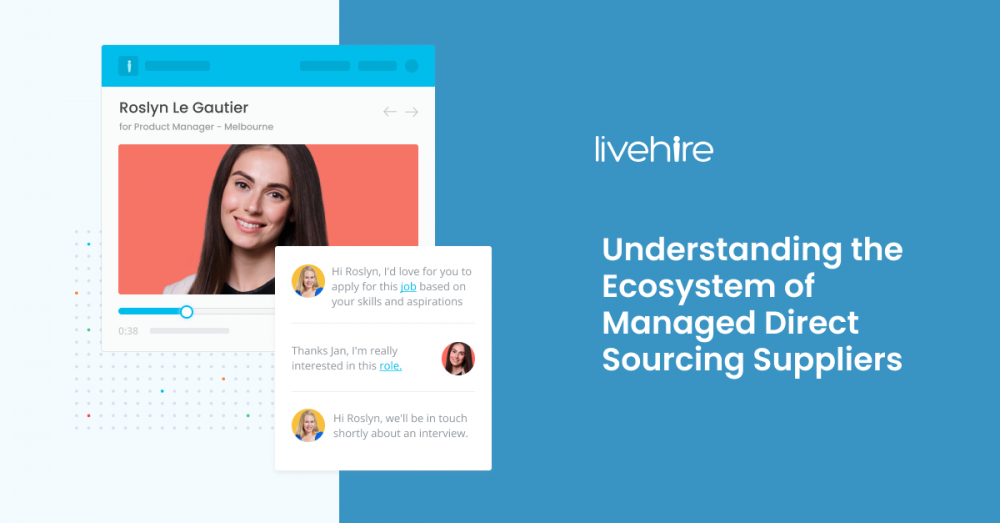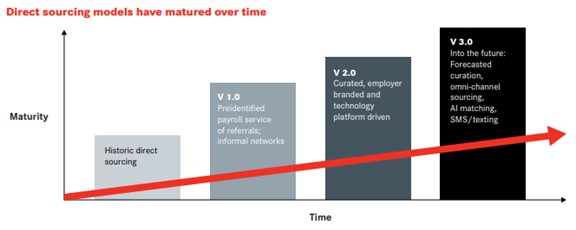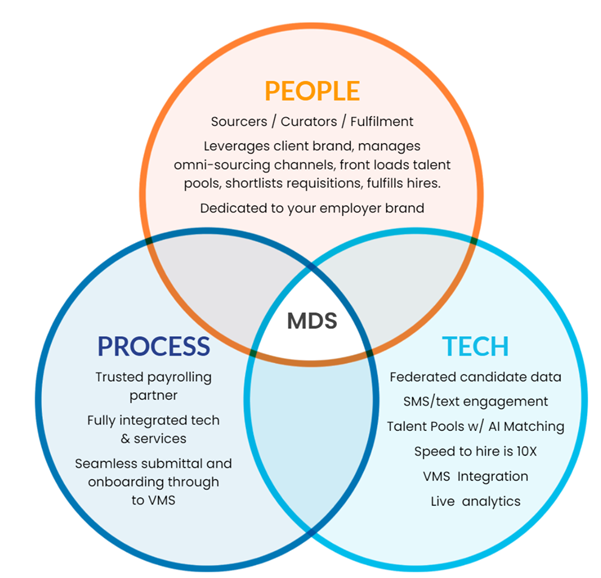
In the post-Covid economic environment, many candidates are feeling more empowered than ever before. In April 2021, 4 million US workers quit their jobs and there were over 9 million open roles that companies were unable to fill. Not surprisingly, employees have heightened expectations for work-life balance and flexible employment arrangements that companies are racing to catch up with.
Meanwhile, the latest data from Ardent Partners indicates that 46.5% of the US workforce now comprises non-employees (i.e. contingent workers). With the rapid rise of the contingent workforce, there is a heightened need for business model evolution to keep pace with the demands of this changing dynamic.
For many organizations with mature contingent workforce programs, significant efficiencies have been gained over the past 10 years by leveraging Vendor Management Systems and/or Managed Service Providers. But what’s the next big innovation? The dramatic shift in workforce composition toward contingent workers is driving many business leaders to look for new ways to drive efficiencies and win the war for talent.
As such, Direct Sourcing is becoming the leading trend in contingent workforce management today. 60% of organizations surveyed by Staffing Industry Analysts (SIA) are aiming to prioritise Direct Sourcing over all other workforce strategies in the next 2 years. Yet, for many the challenge lies in how to successfully navigate new technology, partners, and processes for seamless implementation. In fact, data from Staffing Industry Analysts (SIA) market research found just 16% of 158 contingent workforce managers strongly agree Direct Sourcing is currently being effectively implemented. Having a centralized model for your Direct Sourcing is key to achieving success when hiring your contingent workforce and it’s no different when engaging with a third party for Managed Direct Sourcing. To start, it’s critical to understand the different roles, tasks, and technologies that each person or department would manage in your processes.
Before discussing further, what is Managed Direct Sourcing as it pertains to contingent workforce recruitment?
Managed Direct Sourcing (MDS) is the use of third-party staffing suppliers to grow, curate and engage your branded talent pools as a managed service, filling your contingent job requisitions with qualified candidates on-demand.
MDS programs offer the benefits of traditional Direct Sourcing strategies, but use external sources and curators to manage your branded talent cloud for your contingent workforce. Talent is directly sourced and the employer brand is leveraged to attract the best talent via a candidate-centric experience.
If you are still considering the benefits of investing in MDS check out our thoughts on it here, and we’ve also curated an evidence-based article on the common myths of MDS here (debunking them all with cold hard data).
You may have decided that a Direct Sourcing strategy is right for your business. Where to from here? A critical next step is to architect the right program for you and your organization. Direct Sourcing is rarely, if ever, done internally. Typically, it is done with suppliers leveraged through outsourced programs. This is made up of an ecosystem of as many as 5 specialized solution providers, enabling optimized programs across the globe. Read-on to understand what each key partner offers, why it’s important and what the risks and opportunities are for tackling each element in-house.
The 5 key supplier partners for Managed Direct Sourcing
There are 5 key supplier partners that make up an optimized MDS program;
- Staffing partner
- Payroll partner (sometimes the same as your staffing partner)
- Managed Service Provider (MSP)
- Vendor Management System (VMS)
- Direct Sourcing Technology partner
Seems like a lot. You may be wondering…
- How do they all work together?
- Wouldn’t there be repetition?
- Haven’t you named technology twice?
- How will they affect my current supplier relationships?
Here’s how it works. The Direct Sourcing technology partner builds a branded Talent Cloud to attract and engage contingent workers. Your preferred staffing partner manages and curates your Talent Cloud to create role-specific Talent Pools for rapid sourcing at a reduced rate. The staffing partner may also offer payrolling services and act as the employer of record, or that role may be performed by another provider. Meanwhile, your MSP and VMS continue to operate in their existing roles to oversee the entire contingent workforce program.
The operational view of Managed Direct Sourcing
As depicted in the diagram below, you can see the operational view of how you can combine world leading technology, an experienced, industry leading staffing partner, and a trusted payroll provider to offer a seamless experience, turnkey MDS solution for your contract workforce:
Now let’s take a deep dive into each partner and their why factor.
Staffing Partners
For fear of stating the obvious, staffing partners are defined by Staffing Industry Analysts as “Companies that provide staffing, workforce solutions and related services to client organizations”.
The role of the staffing partner in a Managed Direct Sourcing program is to be your exclusive talent curation partner. They have trained recruiters who source and nurture talent and are set-up well to be able to provide talent curation services through your branded Talent Cloud.
Can you succeed without Staffing Partners?
If you go down the route of not using staffing partners to deliver your Direct Sourcing solution, then you will need to have in-house recruiters doing the sourcing and nurturing of talent for your talent cloud. Is this doable? Absolutely. But the questions to ask yourself when putting together your program strategy are along the lines of:
- What capacity does our current internal talent acquisition team have?
- Is this team geared for contingent hiring at speed, or perm hiring at a slower pace?
- Where will this internal TA team for MDS report into? If procurement owns the category, do they still report to HR, or into procurement now?
Benefits of Staffing partners
- Experienced sourcing team
- Faster time-to-submit
- Focus on contingent hires ensures the contingent value proposition (CVP) is not confused with the employee value proposition (EVP)
Payroll Partners
Whether you have an in-house payroll team for permanent staff or not, it is important to think independently about how you conduct payroll for your contingent workforce. Why might organizations engage an external company to handle all payroll functions?
- Saves time and money
- Reduces the need for in-house trained payroll staff
- Reduces dependency on purchasing and maintaining appropriate software packages
- For compliance and risk mitigation
These are the most prominent reasons payroll providers are engaged and offer benefits to CWP leaders. Of note in some instances, the staffing partner may also provide payroll services. Further, it’s important to be aware that whoever does the payroll will be the ‘employer of record’.
Can you succeed without Payroll Partners?
Possibly, but you’d be a rarity in the contingent workforce management space. Payroll providers offer competitive pricing, optimized service delivery and reduced risk exposure.
Managed Service Providers (MSPs)
GRI is a leading MSP in North America and offers a detailed description of MSP services:
“A Managed Service Provider manages the contingent worker recruitment for an organization and is responsible for the end-to-end management of the contingent workforce – from supplier management to strategic workforce planning. Employing a MSP is one of the most effective, cost-efficient ways for a business to manage its contingent workforce.”
MSPs play the same role in MDS as they do in non-direct sourcing programs. It’s unlikely that 100% of your contingent workers will be direct sourced, so there is still a requirement for staffing firms to manage job orders. As such, you still need an MSP in place to oversee the entire program.
Can you succeed without an MSP?
According to SIA’s recent Buyer Survey, “adoption of MSPs by companies with more than 1,000 employees has grown from just over 40% in 2009 to 62% in 2020.” Furthermore, global spend on MSPs was estimated at $151 billion as recently as 2019, with the vast majority of spend occurring in North America and Europe.
Can you succeed without an MSP? Sure you can, if you have the capacity and internal expertise to manage a large contingent workforce program. Otherwise, it makes a lot more sense to collaborate with established and experienced MSPs.
Vendor Management Systems (VMS)
From 2013 it has been estimated 75% of Fortune 1000 companies have been using VMSs to manage contingent workers. During the global pandemic the global Vendor Management Software market was estimated at US$5.1 Billion. However, it is expected to reach US$11.5 Billion by 2027. VMS’ are well-established in contingent workforce programs and will continue to play an important role in a Managed Direct Sourcing scenario. A VMS is a software application that allows an organization to secure and manage staffing services on a temporary or contract basis. A VMS enables you to oversee existing contingent workers in a centralized core platform, which is critical given the numerous technologies involved in staffing your contingent workforce.
Can you succeed without a VMS?
To a degree this depends on your program spend under management. If your contingent staffing administration is manual and in danger of lack of compliance, now is the time to consider a VMS. Their role is not to be underestimated when putting together your MDS program.
Direct Sourcing Technology Partners
And last but not least, Direct Sourcing technology partners. In fact, you may have understandably assumed we had already covered this with VMS? Not quite. The key to Direct Sourcing is the ability to build a Talent Cloud of curated talent. To do this you need to implement a digital staffing platform. This technology needs to provide a positive candidate experience while allowing your MSP or staffing partners to source and engage with high quality potential candidates.
Ardent recently released a research report on the digital staffing platform market, which dives into the deep technology landscape for HR, procurement, human capital management, and talent acquisition leaders to discuss and explore the key functionality, capabilities, competencies, offerings, and performance of the main providers in the digital staffing platforms space.
You can download the full report here.
In Summary
Each of the 5 key stakeholders in a successful MDS program plays a distinct role, with no duplication – of activities or spend. Given the efficiencies and extended experience available for each group, with competitive commercial models, there’s a strong business case for leveraging the market leaders to develop your MDS program. For more information, read why you should invest in a Managed Direct Sourcing Program or speak to our team today to find out how a Managed Direct Sourcing program could work in your organization.





